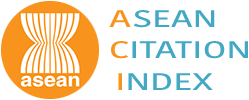การประเมินพื้นที่สิ่งปลูกสร้างด้วยดัชนีปรับปรุงค่าสิ่งปลูกสร้าง ร่วมกับภาพถ่ายจากดาวเทียม Landsat 8 และ Sentinel - 2A
คำสำคัญ:
ดัชนีปรับปรุงค่าสิ่งปลูกสร้าง , พื้นที่สิ่งปลูกสร้าง , Landsat 8 , Sentinel - 2Aบทคัดย่อ
วัตถุประสงค์และที่มา : ดัชนีปรับปรุงค่าสิ่งปลูกสร้าง (MBUI) ได้ถูกพัฒนาขึ้นเพื่อการจำแนกการใช้ประโยชน์ที่ดินจากภาพถ่ายจากดาวเทียม Landsat 8 แต่ยังไม่มีการประยุกต์ใช้ดัชนีนี้กับข้อมูลที่มีค่าความละเอียดเชิงพื้นที่ที่สูงกว่า การวิจัยนี้จึงมีแนวคิดในการประยุกต์ใช้ MBUI ร่วมกับภาพถ่ายจากดาวเทียม Landsat 8 และ Sentinel - 2A ในเขตกรุงเทพมหานครและปริมณฑล เพื่อทำการประเมินและตรวจสอบความถูกต้องของพื้นที่สิ่งปลูกสร้าง ที่ได้จากข้อมูลที่มีความละเอียดเชิงพื้นที่แตกต่างกัน สำหรับใช้เป็นแนวทางในการเลือกใช้ข้อมูลภาพถ่ายจากดาวเทียมในการประเมินพื้นที่สิ่งปลูกสร้าง
วิธีดำเนินการวิจัย : กำหนดให้ทำการแปลงค่า NDVI, NDBI และ MNDWI ให้เป็นค่าจำนวนเต็ม (0 และ 254) โดยใช้เงื่อนไขของค่าขีดแบ่งเดียวกันทุกภาพ ใช้วิธีการสุ่มตัวอย่างแบบสุ่มในการวางตำแหน่งจุดตัวอย่าง และประเมินความถูกต้องด้วยสถิติเชิงพรรณนาแบบง่ายและสถิติเชิงวิเคราะห์แบบหลายตัวแปร
ผลการวิจัย : ข้อมูลภาพถ่ายจากดาวเทียม Landsat 8 และ Sentinel - 2A มีพื้นที่สิ่งปลูกสร้าง 2,956.79 และ 2,906.61 ตารางกิโลเมตร ตามลำดับ และมีค่า KHAT เท่ากับร้อยละ 75.36 และ 79.71 ตามลำดับ
สรุปผลการวิจัย : เงื่อนไขการแปลงค่า NDVI, NDBI และ MNDWI ที่ถูกสร้างขึ้นสำหรับภาพถ่ายจากดาวเทียม Landsat 8 สามารถนำมาประยุกต์ใช้ได้ดีกับภาพถ่ายจากดาวเทียม Sentinel - 2A ที่มีความละเอียดเชิงพื้นที่มากกว่า อีกทั้งยังให้ค่าความถูกต้องสูงกว่า
เอกสารอ้างอิง
Anderson, J.R. (1971). Land use classification schemes used in selected recent geographic applications of remote sensing. Photogrammetric Engineering, 37(4), 379 - 387.
As - syakur, A.R., Adnyana, I.W.S., Arthana, I.W., & Nuarsa, I.W. (2012). Enhanced Built - Up and Bareness Index (EBBI) for Mapping Built - Up and Bare Land in an Urban Area. Remote Sensing, 4(10), 2957 - 2970.
Bouzekri, S., Lasbet, A.A., Lachehab, A. (2005). A New Spectral Index for Extraction of Built - Up Area Using Landsat - 8 Data. Journal of the Indian Society of Remote Sensing, 43(4), 867 - 873.
Cao, R., Chen, Y., Shen, M., Chen, J., Zhou, J., Wang, C., & Yang, W. (2018). A simple method to improve the quality of NDVI time - series data by integrating spatiotemporal information with the Savitzky - Golay filter. Remote Sensing of Environment, 217, 244 - 257.
Dousset, B., & Gourmelon F. (2003). Satellite multi - sensor data analysis of urban surface temperatures and land cover. ISPRS Journal of Photogrammetry and Remote Sensing, 58(1 - 2), 43 - 54.
He, C., Shi, P., Xie, D., & Zhao, Y. (2010) Improving the Normalized Difference Built - Up Index to Map Urban Built - Up Areas Using a Semiautomatic Segmentation Approach. Remote Sensing Letters, 1(4), 213 - 221.
Hutasavi, S., & Chen, D. (2021). Multi - Temporal Mapping of Built - up Areas Using Daytime and Nighttime Satellite Images Based on Google Earth Engine Platform. International Journal of Civil and Architectural Engineering, 15(6), 345 - 353.
Ji, L., Zhang, L. , & Wylie, B. (2009) Analysis of Dynamic Thresholds for the Normalized Difference Water Index. Photogrammetric Engineering and Remote Sensing, 75(11), 1307 - 1317.
Kawamura, M., Jayamana, S., & Tsujiko, Y. (1996). Relation between Social and Environmental Conditions in Colombo Sri Lanka and the Urban Index Estimated by Satellite Remote Sensing Data. International Archives of Photogrammetry and Remote Sensing, 31(Part B7), 321 - 326.
Land Development Department (LDD). Ministry of Agriculture and Cooperatives. (2023). Land Use. https://dinonline .ldd.go.th/ (in Thai)
Landis J.R., & Koch G.G. (1977). The measurement of observer agreement for categorical data. Biometrics, 33, 159 - 174.
McFeeters, S.K. (1996) The Use of the Normalized Difference Water Index (NDWI) in the Delineation of Open Water Features. International Journal of Remote Sensing, 17, 1425 - 1432.
Maqsoom, A., Aslam, B., Yousafzai, A. Ullah,S., & Imran, M. (2022). Extracting built - up areas from spectro - textural information using machine learning. Soft Computing, 26, 7789 - 7808.
Prasomsup, W., Piyatadsananon, P., Aunphoklang, W., & Boonrang, A. (2020). Extraction Technic for Built - up Area Classification in Landsat 8 Imagery. International journal of environmental science and development, 11(1), 15 - 20.
Rouse, J.W., Haas, R.H., Schell, J.A., & Deering, D.W. (1974). Monitoring Vegetation Systems in the Great Plains with ERTS. In Third ERTS - 1 Symposium. (pp. 309 - 317). Washington, D.C.: Goddard Space Flight Center.
Shao, Z., Tian, Y., & Shen, X. (2014). BASI: a new index to extract built - up areas from high - resolution remote sensing images by visual attention model. Remote Sensing Letters, 5(4), 305 - 314.
Szabó, S, Gacsi, Z., & Boglárka, B. (2016). Specific features of NDVI, NDWI and MNDWI as reflected in land cover categories. Landscape and Environment, 10(3 - 4), 194 - 202.
USGS. (U.S. Geological Survey). (2023). Landsat Normalized Difference Vegetation Index. https://www.usgs.gov/ landsat - missions/landsat - normalized - difference - vegetation - index.
Vaddiraju, S.C., T, R., & Savitha, C. (2022). Determination of impervious area of Saroor Nagar Watershed of Telangana using spectral indices, MLC, and machine learning (SVM) techniques. Environmental Monitoring and Assessment, 194, 258.
Xu, H. (2005). A Study on Information Extraction of Water Body with the Modified Normalized Difference Water Index (MNDWI). Journal of Remote Sensing, 9, 589 - 595.
Xue, J., & Su, B. (2017). Significant Remote Sensing Vegetation Indices A Review of Developments and Applications. Journal of Sensors, 2017, Article ID 1353691.
Zha, Y., Gao, J., & Ni, S. (2003). Use of normalized difference built - up index in automatically mapping urban areas from TM imagery. International Journal of Remote Sensing, 24(3), 583 - 594.
ดาวน์โหลด
เผยแพร่แล้ว
รูปแบบการอ้างอิง
ฉบับ
ประเภทบทความ
สัญญาอนุญาต
ลิขสิทธิ์ (c) 2024 คณะวิทยาศาสตร์ มหาวิทยาลัยบูรพา

อนุญาตภายใต้เงื่อนไข Creative Commons Attribution-NonCommercial-NoDerivatives 4.0 International License.
Burapha Science Journal is licensed under a Creative Commons Attribution-NonCommercial-NoDerivatives 4.0 International (CC BY-NC-ND 4.0) licence, unless otherwise stated. Please read our Policies page for more information




